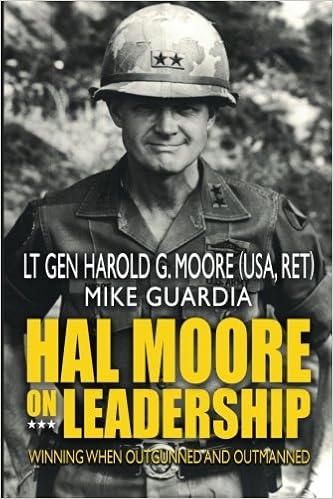
Mike Guardia’s Hal Moore on Leadership: Winning when Outgunned and Outmanned (CreateSpace/Magnum Books, 168 pp., $14.95, paper: $4.99, Kindle) is part biography and part a recounting of leadership lessons developed over a lifetime by Lt. Gen. Hal Moore. The late Gen. Moore is best known for his stellar leadership at the pivotal Battle of the Ia Drang Valley in Vietnam in 1965, and for the epic book he and Galloway wrote about it, We Were Soldiers Once… and Young. In that widely praised book—and in Moore and Galloway’s We Are Soldiers Still—many of the Moore’s leadership points are explored.
Guardia begins with a narrative of the fight at Landing Zone X-ray at the Ia Drang. He then introduces the reader to Hal Moore, concentrating on the principles of the man and the leadership traits he developed during more than thirty years as a military leader.
Over time, Moore crystalized his philosophy of leadership into four main principles.
First: Three strikes and you are not out.
Second: There is always one more thing you can do to influence any situation in your favor, and after that there is one more thing.
Third: When nothing is wrong, there is nothing wrong—except there is nothing wrong. That is when a leader has to be the most alert
Last: Trust your instincts.
Guardia illustrates each of the principles with real-life examples. Perhaps none of them is more touching than the story of Rick Rescorla, one of Moore’s platoon leaders in Vietnam, and one of the heroes of the September 11 attacks in New York City.
Throughout the biographical narrative, Guardia intersperses the leadership points and attributes Moore developed over a lifetime of service and later in his work in the business world. In addition to a generous collection of photographs, Guardia includes several of Moore’s speeches to the business and professional sports communities he often advised.
The book reveals the man and the circumstances that helped him develop his principles. It also touches on the role Moore’s faith played in developing his character. One of the more revealing stories Guardia tells is that of Hal Moore’s courtship and subsequent marriage to Julia Compton, the daughter of a professional artilleryman.

Then Lt. Col. Hal Moore at LZ X-Ray in the Ia Drang Valley.
The book is a profile of the man and his development into the dynamic leader he was. Moore’s leadership points are well placed amid the biographical details.
This is a good book, a blueprint for leaders of all sorts, military as well as business.
The author’s website is mikeguardia.com
—Bud Alley
Editor’s note: VVA member Bud Alley served under Hal Moore in HHC of the 2/7 in the 1st First Cavalry Division in Vietnam in 1965-66. He was a close friend of Rick Rescorla. Both men, he says, “were dynamic leaders of the highest magnitude.”




